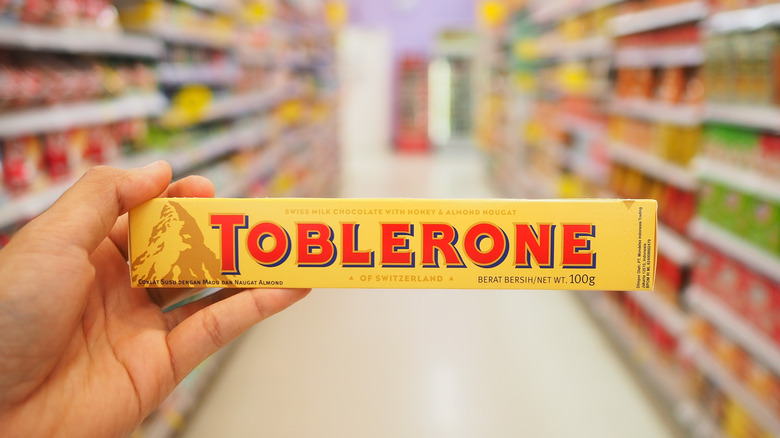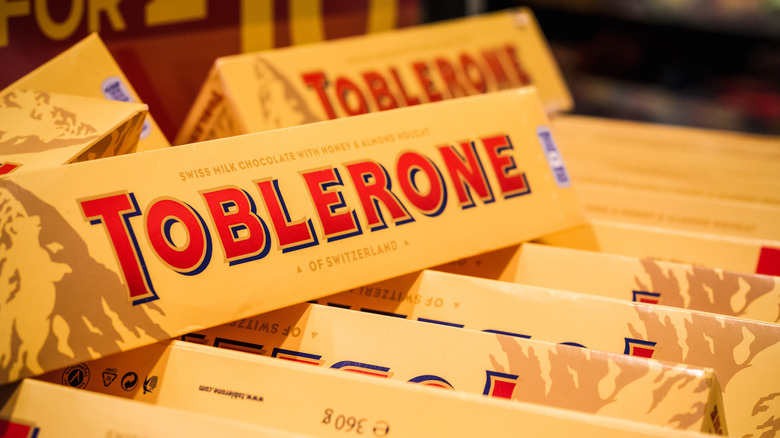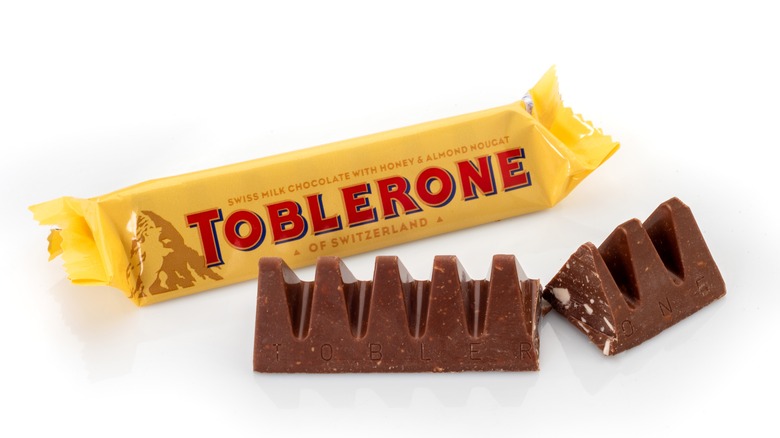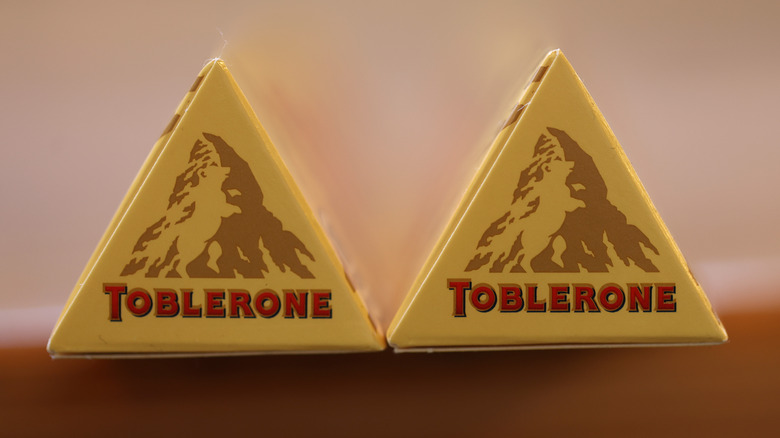Everything You Should Know About Toblerone Chocolate
Like designer perfume, fancy tequila, and cell phone chargers, Toblerone is a mainstay in airport duty-free stores around the world. With its unmistakable triangle shape and bright gold packaging, it's easy to spot — and frankly, pretty hard to resist. As many of the most iconic chocolate brands do, Toblerone hails from Switzerland. The bar boasts a honey-and-white nougat filling that not only gives it a chewy, crunchy texture but was actually quite the novelty when the brand was launched at the beginning of the 20th century.
Now, 125 years later, Toblerone's worldwide popularity has reached great heights: rumor has it that if we laid out every single Toblerone bar that is sold each year, the long line of chocolates would be 62,000 kilometers (38,525 miles) long, which is more than the Earth's circumference (in case you are wondering, it's 40,000 kilometers or 24,900 miles long when measured around the Equator). If you can't get enough Toblerone facts, keep on reading to learn more.
Birth of a legend
For most chocolate lovers, Toblerone is a household name, even making an appearance on a Friends episode (fans will remember Joey asking Ross to "pick me up one of those Toblerone bars at the airport"). Yet the chocolate brand has had a long and fascinating history on its way to becoming so ubiquitous. Its origins take us to 19th-century Switzerland, where a young fellow named Jean Tobler began his professional career as an apprentice in a confectionery. By 1868, Tobler decided to take an entrepreneurial risk and open his own shop in Bern, producing sweets using chocolate from other Swiss chocolatiers.
Tobler found plenty of success with his shop and acquired sufficient skills and experience to become a master chocolatier. In 1899, at the age of 68, he founded Fabrique de Chocolate Berne alongside his two sons, Theodor and Emil. Only a year later, Jean passed away, and the business officially belonged to his kids. They took it seriously. In fact, Theodor built his family's house right next door to the factory.
Shaping an identity
After exploring and experimenting with different recipes, Theodor Tobler and Emil Baumann finally chose a combination of milk chocolate, honey, and white nougat for Toblerone, which was launched in 1908 and was actually the first chocolate with a filling to hit the market. The nougat also played a part in naming the product: Toblerone blends the last name Tobler and torrone, the Italian word for honey and almond nougat.
While many fans believe that Toblerone's triangular shape is inspired by the Swiss mountains, the story behind it is French. Back in Tobler's day, there was a popular dance cabaret in Paris called Folies Bergère. At the end of the act, dancers would form a human pyramid, which Tobler found quite impressive. That artistic endeavor is the real reason the chocolate bar boasts a series of pyramids.
But as much as Tobler loved this shape, it wasn't precisely a hit with customers when it first hit the shelves. Theodor was clever enough to use the controversy to the brand's benefit, considering it a marketing opportunity. Eventually, the chocolate became a hit. The company's annual revenue hit more than 100 million francs by 1919.
The more the merrier
The brand's popularity and high demand for its triangle-shaped chocolate resulted in the opening of a new factory in Bern in 1985. Five years later, Toblerone was acquired by food conglomerate Mondelēz, which also owns brands like Philadelphia and Trident, plus other big names in chocolate like Milka and Cadbury. According to Mondelēz, Toblerone is currently enjoyed in more than 100 countries and is the top chocolate brand in travel retail.
Over time, the Toblerone selection has grown and evolved. In 1969, dark chocolate Toblerone was introduced, boasting a forest-green wrapper that was later changed to the black we know today. Later, the brand launched a white chocolate version, as well as Toblerone Fruit & Nut, which came out in 2008. Other flavors include Crispy Coconut (discontinued in 2020), and most recently, Orange Twist, and Crunchy Salted Almonds. Toblerone sizes also vary, ranging from bite-sized Tiny triangles to a massive 10-pound (4.5 kilograms) bar and the recently-introduced Truffles.
The importance of Bern
Bern, the capital city of Switzerland, is where it all started for the Tobler family. From Jean's early days as an apprentice to the launch of Toblerone in 1908, the riverside city holds the history of Toblerone. It is also where chocolate production has taken place — so far.
Last year, Mondelēz announced that it would move some of its chocolate production to Bratislava, Slovakia, where it also produces Suchard and Milka. The move aims to cut production costs and respond to high product demand. Toblerone currently makes 7 billion bars each year, 97% of which are exported. And while Bern will still host some of the brand's production, including its 100-gram bars, the Slovakia move will have some consequences on the brand's labeling.
For starters, Toblerone will have to remove the legend "Swiss-made chocolate" from its packaging, as Swiss laws established in 2017 dictate that brands must source agricultural products such as milk locally to earn the rights to boast this term. But the changes don't stop there.
All about the wrapping
Throughout its history, Toblerone's packaging has been an essential part of its identity. In its early days, the wrapper featured an eagle, which was replaced by a bear in 1920. The bear is another tribute to the city of Bern, as it represents its coat of arms. Half a century later, another very Swiss symbol made its appearance on the packaging: the Matterhorn. Standing in the Swiss Alps, the mountain's imposing, jagged silhouette has made it has long been one of the most recognizable natural formations in the country — not to mention a challenge for alpinists around the world, with its 14,690-foot (4,478 meters) height.
If you look closely at the Matterhorn on the Toblerone package, you will see the outline of a bear camouflaged into the mountain. But all of that is about to change. Due to Mondelēz's decision to move some of its production to Slovakia, it will have to remove the Matterhorn from the Toblerone packaging, since Swiss production laws dictate that national symbols cannot be used to promote milk-based products that are not 100% made in the country.
Beyond the bar
While the pyramid-shaped bar is ever-present in stores and airports around the world, there are a few specialty Toblerone items that are only available in certain regions. Take the Toblerone Chocolate Cake, created in partnership with Swedish bakery Almondy. The cake boasts an almond base, layers of chocolate mousse, chunks of Toblerone bars, and chocolate drizzle. The cake, which is vegetarian and gluten-free, is a bit of a rare find in the United States, but if you're lucky, you can find it in your local store's frozen foods aisle.
Last winter, UK-based Costa Coffee teamed up with Toblerone to launch specialty holiday drinks, offering a latte and a hot chocolate to warm up the holiday season. Drinks were served with a whipped cream topping and a tiny Toblerone bar on the side. If you missed that collab, you can always make your own Toblerone hot chocolate by melting the bar in hot milk.
Toblerone has a platform that allows fans to personalize their chocolate bars, from size and flavor to the packaging. Wrapping options include fashion, art, and music-themed patterns, plus the possibility to write the recipient's name and a customized message. The brand also launched bespoke designs for celebrations such as Easter and Father's Day.
Chocolate culture
The first association most of us make with Toblerone is travel. It's hard to walk by an airport duty-free shop without spotting the shiny golden packages on a shelf or, even better, stacked together to form a tower or a pyramid. The fact that Toblerone seems more readily available at an airport than at a grocery store means that we perceive it as a more glamorous, exclusive brand, associating it with international journeys.
Toblerone's presence in culture goes well beyond the chocolate itself, with the name making its way to historic and architectural sites. Take the Promenthouse Line, for example. This long line of anti-tank defenses runs from the Jura mountains to Lake Geneva and was placed in this strategic position during World War II when Switzerland found itself facing possible invasions from Italy and Germany. The concrete hunks resemble the triangles in a Toblerone bar, and the defense line eventually earned this nickname: the Toblerone line. Today, tourists can even hike along parts of the grassy area.
Serbia boasts its own chocolate-themed site as well. Built between 1960 and 1963 and designed by Rista Sekerinski, the Karabuma residential tower is not only a great example of Brutalist architecture — with triangular shapes that stick out of the tower, it reminds residents of the chocolate bar, so much so that they have nicknamed it the Toblerone tower.
A dose of controversy
Throughout 125 years of Toblerone history, there have been a couple of not-so-sweet moments. One of them is known as "The Toblerone affair," and it happened back in the mid-nineties when Swedish politician Mona Sahlin was forced to take three years off politics when she was caught buying thousands of dollars in luxury goods using her party's credit card — including a few bars of Toblerone. Sahlin came under fire again in 2010, when Sweden's Anti-Corruption Unit investigated her decision to accept complimentary tickets to the ATP Stockholm Open tournament.
In 2016, the controversy came courtesy of Mondelēz itself, when the company changed the design of the 400-gram and 170-gram Toblerone bars. As a response to a rise in the cost of ingredients, the US-based company spaced out the triangles in the bars, seeking to cut production costs. The resulting bars were 360 grams and 150 grams, respectively. Customers, however, were not happy. Two years later, Mondelēz brought the original shapes back.
What happens now?
After the recent announcement that Toblerone would have to remove the iconic Matterhorn summit from its packaging, Mondelēz announced that the chocolate's label would undergo a complete redesign. The Matterhorn's jagged silhouette will be replaced with a more generic mountain, while founder Jean Tobler's signature will make an appearance on the packaging. Mondelēz also told the BBC that the new packaging will draw more inspiration from the brand's history and will feature a redesigned Toblerone logo and font as well.
The brand has always shown great pride in its history. Case in point: the "Be More Triangle" campaign, launched in 2021 to celebrate its history and to urge fans to celebrate their own uniqueness and quirks. With that in mind, it makes sense that historic elements will still be relevant in this upcoming rebranding. One thing is for sure: We will all be eagerly waiting for this new image to be revealed.
Why can't Toblerone market itself as Swiss?
The new regulations for everything Swiss-made came into force in January 2017. These rules regulate who can use the term "made in Switzerland" as well as the white cross on a red background. According to the Swiss Confederation, these regulations aim to protect the Swiss brand's value, which can represent up to 20% of the price of certain products and even 50% of luxury items, such as watches and cosmetics.
For a product to be considered Swiss and to be able to market itself as such, it must meet strict criteria. When talking specifically about foodstuffs, at least 80% of the raw materials must be sourced in Switzerland; if they are milk or dairy-based products (like cheese or chocolate), 100% of the milk must be considered. If a brand or product does not meet all of the criteria, they may carry out part of the process in Switzerland in full, and state so on their label, with a legend like "designed in Switzerland." They can't, however, use the Swiss cross. This symbol is only allowed for products that meet all of the Swiss provenance criteria.










